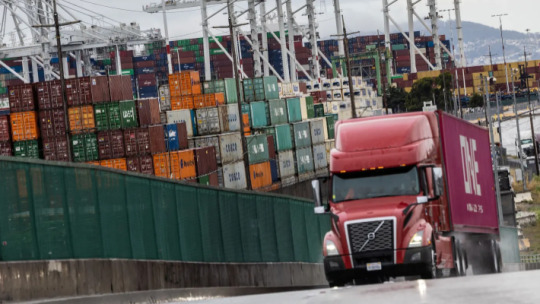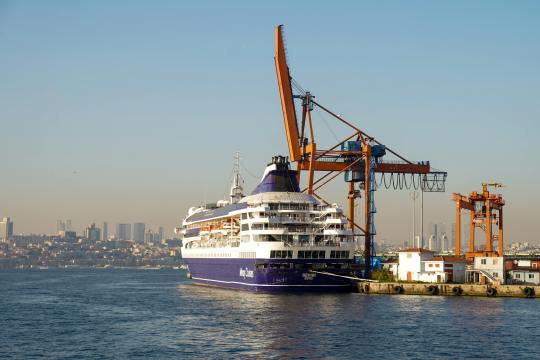#CustomsDuties
Explore tagged Tumblr posts
Text
U.S. Tariff Revenue Hits Record $16.3 Billion in April, Offers Temporary Relief to Budget Deficit
U.S. tariff collections soared to an all-time high in April, injecting a temporary boost to federal revenues and helping trim the monthly budget deficit, according to new data released by the Treasury Department.
Tariff receipts reached $16.3 billion last month — more than double the amount collected in April 2024 and 86% higher than the $8.75 billion reported in March. The surge follows the full implementation of 10% across-the-board import tariffs enacted by former President Donald Trump on April 2, which added to a growing list of targeted duties already in place.

Since the start of the fiscal year, customs duties have totaled $63.3 billion, marking an 18% increase from the same period last year. The sharp rise in tariff revenue contributed to a $258.4 billion federal surplus in April — traditionally a strong month due to income tax filings — representing a 23% increase from a year ago.
Despite the April surplus, the U.S. continues to face a steep fiscal imbalance. The cumulative fiscal year-to-date deficit now stands at $1.05 trillion, up 13% from the same point in 2024. Total receipts in April rose 10% year-over-year, while federal outlays fell 4%. However, on a year-to-date basis, government expenditures are still outpacing revenues, rising 9% compared to a 5% increase in income.
A key driver of spending growth remains the rising cost of servicing the national debt, now exceeding $36 trillion. In April alone, net interest payments totaled $89 billion, making it the second-largest federal expense after Social Security. For the fiscal year so far, interest costs have reached $579 billion — also the second-highest expenditure category.
While the tariff windfall provided a temporary cushion to federal coffers, economists caution that the broader economic impact of the trade measures — including slower growth and elevated consumer prices — could offset the fiscal gains in the long run.
0 notes
Text
Merchandise Processing Fee (MPF): A Complete Guide
The merchandise processing fee is a U.S. Customs charge applied to most imports entering the United States. It’s an essential cost that importers need to understand when calculating the total expense of bringing goods into the country.
1. What is MPF?
The merchandise processing fee is a fee collected by U.S. Customs and Border Protection (CBP) to cover the cost of processing goods entering U.S. ports. It applies to both formal and informal entries, though the rates and rules differ depending on the type of entry.
2. MPF for Formal Entries
For commercial imports valued over $2,500, the MPF is calculated as a percentage of the declared value of the goods. The current rate is 0.3464%, with a minimum charge and a maximum cap applied per entry to avoid excessively low or high fees.
3. MPF for Informal Entries
For shipments valued under $2,500 or those that qualify for informal processing (like personal packages), a flat fee is usually applied instead of a percentage-based rate.
4. Who Pays the Fee?
The importer of record is responsible for paying the merchandise processing fee, typically at the time of customs clearance. It is often included in the total customs duties and taxes paid by the broker on behalf of the importer.
5. Why It Matters?
Although the MPF may seem like a minor cost, it can add up significantly for businesses that import frequently. Properly accounting for this fee helps companies maintain accurate financial and logistics planning.

0 notes
Text
Hey everyone,
If you’re working in international trade, taxation, or customs, you know how important it is to understand transfer pricing—especially in today’s complex global economy. That’s why I highly recommend checking out the Fundamentals of Transfer Pricing course, co-developed with the OECD, which dives deep into the intersection of transfer pricing and customs regulations. This updated course is packed with practical insights and is ideal for anyone wanting to stay ahead in international tax and trade compliance.
Why This Course is a Game-Changer:
OECD-Endorsed Content: Learn directly from the international body setting global tax guidelines.
Rules of Origin & Transfer Pricing: Master how transfer pricing relates to rules of origin in international trade, and how to ensure compliance with both tax laws and customs duties.
Arm’s Length Principle: Understand the core concept behind the arm’s length principle and how to apply it in cross-border transactions to stay compliant.
Real-World Methods: Gain hands-on knowledge of popular transfer pricing methods like the CUP method, Resale Price Method, and more, to ensure accurate pricing in global trade.
Key Takeaways:
International Tax Framework: Get a solid grasp of the OECD guidelines and tax treaties that influence global transfer pricing rules.
Comparability & Adjustments: Learn how to assess comparability in cross-border transactions and handle primary/secondary adjustments.
Dispute Avoidance: Discover effective dispute resolution mechanisms like Advance Pricing Agreements (APAs), Mutual Agreement Procedure (MAP), and Arbitration to prevent transfer pricing conflicts.
Bonus:
Practical Focus: The course offers hands-on examples to help you apply transfer pricing methods in real-world trade scenarios.
Tax & Customs Integration: Gain a comprehensive understanding of how tax treaties and customs duties interact with transfer pricing and how to navigate these challenges.
If you're involved in cross-border transactions, this course will equip you with the tools and knowledge you need to navigate complex transfer pricing and taxation issues with confidence.
For more details and to register, check out the full course here: Fundamentals of Transfer Pricing
Got any questions or thoughts on transfer pricing? Drop them in the comments—I’d love to hear your experiences!
#TransferPricing #InternationalTax #OECD #CustomsRegulations #GlobalTrade #TaxCompliance #CrossBorderTransactions #TradeCompliance #ArmLengthPrinciple #TaxTreaties #OECDGuidelines #CustomsDuties #AdvancePricingAgreements #MutualAgreementProcedure #MAP #InternationalBusiness #GlobalEconomy #TaxAndCustoms #TransferPricingMethods #GlobalTaxation #CustomsTraining #TradeTaxation
#TransferPricing#InternationalTax#OECD#CustomsRegulations#GlobalTrade#TaxCompliance#CrossBorderTransactions#TradeCompliance#ArmLengthPrinciple#TaxTreaties#OECDGuidelines#CustomsDuties#AdvancePricingAgreements#MutualAgreementProcedure#MAP#InternationalBusiness#GlobalEconomy#TaxAndCustoms#TransferPricingMethods#GlobalTaxation#CustomsTraining#TradeTaxation
0 notes
Text
Trump scales back tariff orders: Here is the latest tariff news, explained


It’s been another chaotic week of shifting tariff updates from Washington, following the expiration of the month-long Read More...
#explained#Here are some possible tags for the topic ****:#-#TrumpTariffUpdates#TariffNews#TradePolicy#EconomicImpact#TariffChanges#TrumpAdministration#TradeRelations#USChinaTrade#GlobalEconomy#TariffExplained#USTradePolicy#TradeNegotiations#CustomsDuties#InternationalTrade#EconomicPolicies#Would you like any more suggestions or details on any of these topics?
1 note
·
View note
Link
Guide to Customs Tariff Classification in Indonesia
#BTI#ImportRegulations#CustomsDuties#CustomsLaw#Tradeagreements#HSCode#tariffclassificationprocess#Indonesia#customstariffclassification#Compliance
0 notes
Text
GACC Registration, or General Administration of Customs of China Registration, is a mandatory process for companies engaged in importing or exporting goods to or from China. It involves submitting detailed information about the company, its products, manufacturing processes, and compliance documentation to Chinese customs authorities. GACC Registration ensures that businesses comply with Chinese customs regulations, including product standards, labeling requirements, and import/export procedures. This registration is essential for gaining approval to move goods across Chinese borders smoothly and legally. Failure to obtain GACC Registration can result in delays, fines, or even the rejection of goods at customs checkpoints.
#GACCRegistration#CustomsCompliance#ImportExportChina#ChinaCustoms#InternationalTrade#CustomsClearance#TradeRegulations#ComplianceDocumentation#CustomsProcedures#CrossBorderTrade#ExportToChina#ImportFromChina#TradeFacilitation#GlobalSupplyChain#TradeCompliance#CustomsBroker#LogisticsManagement#CustomsDeclaration#TariffClassification#ExportDocumentation#ImportDocumentation#CustomsDuties#TradePolicy#TradeAgreements#CustomsBrokerage#TradeLogistics#CustomsProcesses#ExportCompliance#ImportCompliance#CustomsLaw
0 notes
Text
CBIC Removes Fees on Transshipment Applications of the imported goods

View On WordPress
#BISAct#BISExempted#BISRegistration#BISStandard#CBIC#CESTATAhmedabad#Customs#CustomsAct#CustomsAct1962#CustomsAdvanceRuling#CustomsBoard#CustomsClearance#CustomsCompliance#CustomsDepartment#CustomsDuty#CustomsLitigations#Customstariff#Exports#Facebook#GovtofIndia#Imports#IndirectTax#Indirecttaxes#IndirectTaxIndia#IndirectTaxLaw#IndirectTaxLitigations#Indirecttaxmatters#Instagram#LawFirm#Lawyers
0 notes
Video
youtube
(via https://youtube.com/watch?v=DlXcbJ-EMn8&si=IdZ3Rndly-be61oQ)
#youtube#Tariffs TradePolicy GlobalEconomy ImportExport EconomicImpact TradeWar MarketDynamics SupplyChain BusinessInsights CustomsDuties Internation
0 notes
Text
#sharing A Comprehensive Customs Duty Searching website
#sharing A Comprehensive Customs Duty Tool
Navigating global trade complexities? Look no further! 🌐 The website from China's Ministry of Commerce is a game-changer, offering unparalleled insights into cross-border taxes:
https://wmsw.mofcom.gov.cn/wmsw/
Efficiency ✔️ Authority ✔️ Timeliness ✔️
Simply input your country of origin, destination, and HS code, and voila! 📊 Get direct tax rates, framework-specific accord rates, and an overview of taxed items. The site goes the extra mile, providing a handy tax calculator and historical rate reviews, along with adjacent product tax references. 📈
In a nutshell, it's a one-stop shop for rich information and seamless service, ensuring your business stays informed and compliant. 🌍💼
👍 Like if you find this tool invaluable!
💬 Share your thoughts on simplifying global trade.
🔄 Comment your go-to trade resources!
🌐 Because it primarily caters to Chinese traders, the interface is in Chinese. However, you can easily translate it using Chrome.
#GlobalTrade#CustomsDuty#TradeCompliance#BusinessInsights#CrossBorderTrade#TaxRates#TradeTools#ImportExport#BusinessSolutions#CommerceInnovation#TradeSmart#BusinessCompliance#InternationalBusiness#CustomsClearance#TaxCalculation#TradePolicy#ExportImport#BusinessGrowth#TradeSimplified#TradeRegulations
0 notes
Text
36 Life-saving Medications are completely excluded from Customs Duty
36 Life-saving Medications are completely excluded from Customs Duty @neosciencehub #Medications #CustomsDuty #Budget2025to2026 #neosciencehub #GST
In the Union Budget 2025-26, Finance Minister Nirmala Sitharaman declared that 36 life-saving medications will be completely exempt from customs duties, a major step to lessen the financial burden on patients. This program is a component of a larger plan to lower the cost of necessary medical care, especially for cancer patients who have long pushed for less expensive alternatives. A projected…
0 notes
Text
बजट 2021: जानें इस बार क्या हुआ सस्ता और क्या महंगा

चैतन्य भारत न्यूज वित्त मंत्री निर्मला सीतारमण ने सोमवार को आम बजट 2021-22 पेश कर दिया है। आइए जानते हैं इस बार क्या महंगा और क्या सस्ता हुआ है। ये चीजे हुई महंगी शराब पीना होगा महंगा सरकार ने घोषणा की है कि नया एग्री इन्फ्रा डेवलपमेंट सेस कल से ही लागू हो जाएगा। इस हिसाब से कल से शराब पीना भी महंगा होगा, क्योंकि बजट में एल्कोहॉलिक बेवरेज पर 100 प्रतिशत एग्री इन्फ्रा सेस लगाया है। पेट्रोल-डीजल भी महंगे बजट में पेट्रोल पर 2.5 रुपये प्रति लीटर और डीजल पर 4 रुपये प्रति लीटर के हिसाब से एग्री इन्फ्रा सेस लगाया गया है। ऐसे में इनकी कीमत कल से ही बढ़ने की संभावना है। खाने के तेल पर सेस, पर महंगाई का असर नहीं सरकार ने कच्चे पाम तेल पर 17.5% एग्री इन्फ्रा सेस, कच्चे सोयाबीन और सूरजमुखी तेल पर 20% का सेस लगाया है। लेकिन ग्राहकों पर इससे कीमतों का अतिरिक्त भार ना पड़े इसके लिए इन पर बेसिक कस्टम ड्यूटी (बीसीडी) में कटौती की गई है। सेब, खाद, चमड़ा भी महंगा सरकार ने चमड़ा पर सीमाशुल्क को 10% कर दिया है। यह पहले शून्य था। वहीं सेब पर 35% और खाद पर 5% का एग्री इन्फ्रा सेस लगाया है। मोबाइल, रेफ्रिजरेटर, चार्जर भी महंगे बजट में मोबाइल से जुड़े विभिन्न कलपुर्जों पर सीमाशुल्क को शून्य से बढ़ाकर 2.5% किया गया है। वहीं प्रिंटेड सर्किट बोर्ड, चार्जर निर्माण के उपकरण, लीथियम आयन बैटरी, रेफ्रिजरेटर, एयर कंडीशन के कंप्रेसर, एलईडी बल्ब, सोलर इल्वर्टर, सोलर लालटेन पर भी सीमाशुल्क में बढ़ोत्तरी हुई है। सूती कपड़े महंगे बजट प्रावधान लागू होने के बाद आपका कपड़े खरीदने का शौक महंगा हो सकता है। सरकार ने कपास पर सीमाशुल्क को शून्य से बढ़ाकर 5% और कच्चे रेशम पर 10% से 15% कर दिया है। हालांकि नायलॉन के धागे पर उत्पाद शुल्क 7.5% से घटकर 5% रह गया है। ये चीजे हुई सस्ती अप्रैल से सस्ता हो सकता है सोना-चांदी बजट में सोने और चांदी पर उत्पाद शुल्क दरों में कटौती की गई है। इसे 12.5% से घटाकर 7.5% कर दिया गया है। वहीं सोने-चांदी के बिस्कुटों पर भी सीमाशुल्क घटाया गया है। ऐसे में सोने चांदी के सस्ते होने की संभावना है। हालांकि सरकार ने इसी के साथ सोने और चांदी पर 2.5 प्रतिशत का एग्री इन्फ्रा सेस लगाया गया है। इससे तत्काल आधार पर सोने-चांदी की कीमतें बढ़ने की उम्मीद है। इसी के साथ रत्न और नग इत्यादि पर भी सीमाशुल्क को बढ़ाकर 15% किया गया है। ऑटो पार्ट्स महंगे, सस्ते हो सकते हैं वाहन सरकार ने बजट में चुनिंदा ऑटो पार्ट्स पर कस्टम ड्यूटी 7.5% और 10% से बढ़ाकर 15 प्रतिशत कर दी है। वहीं नट-बोल्ट्स पर भी सीमाशुल्क को 10% से बढ़ाकर 15% कर दिया गया है। इससे वाहनों के महंगे होने की संभावना कम ही है। इसकी वजह सरकार ने स्टील सेक्टर के लिए कस्टम ड्यूटी को घटाकर 7.5 प्रतिशत कर दिया है। साथ ही वाहन स्क्रैप पॉलिसी भी घोषित की है जिससे वाहनों की कीमत घट सकती है। ‘आत्मनिर्भर भारत’ के लिए बढ़ा सीमाशुल्क सरकार ने आम बजट 2021-22 ��ो आत्मनिर्भर भारत पर केंद्रित रखा है। इसलिए विभिन्न वस्तुओं पर सीमाशुल्क दरों में परिवर्तन किया गया है। इससे घरेलू उद्योग को बढ़ावा मिलने और आयात पर निर्भरता कम करने में मदद मिलेगी। Read the full article
#30लाखकरोड़#amitshah#bahikhata#bjp#budetnewsinhindi#budget#budget2021#budget2021hindi#budgetchanges#budgetdate#budgethighlights#budgetimportantannouncements#budgetimportantpoints#budgetinfolder#budgetincometax#cabinetministers#CessएवंSurcharge#congress#corporatetax#Customsduties#economicbudget#economicsurvey#EconomicSurvey2021#Exciseduties#financialyear#fiscaldeficit#FiscalPolicy#gdp#incomesourcesofgovernmenttospendinbudget#incometax
0 notes
Text

શાહરૂખ ખાન અને તેની ટીમને મુંબઈ એરપોર્ટ પર રોકવામાં આવી , કસ્ટમ ડ્યુટી ન ભરી હોવાનું પણ કહેવાય છે
0 notes
Link
0 notes
Text
EV Policy (4-Wheelers) Approved-Here are Details – PakWheels Blog
Main Points of EV Policy (4-Wheelers):
Following are the main points of EV Policy (4-Wheelers):
The new policy will remain in force till June 30, 2026.
There will be 1% Customs Duty (CD), no Additional Custom Duty (ACD) or Regulatory Duty (RD) or Value Added Tax (VAT) on EV specific parts for Completely Knocked Down (CKD) units.
There will be 25% CD, and zero ACD or RD on Completely Built Units (CBUs)import.Duty-Free import of plant and machineryfor EV 4-Wheelers.
Every Company can import 100 CBUs with 50% CD.
1% CD on EV Chargers.Import of CKD in small cars and sport utility with 50kWh battery or below, and Light Commercial Vehicles (LCVs) with 150kWh battery would be exempted from Sales Tax, and VAT on imports, but with 1% Sales Tax on Sales.
No Federal Excise Duty (FED) on Electric VehiclesToll Tax on National Highways (NHA) would be 50% for EVsSpecial Window at State Bank of Pakistan (SBP) for EV car financing at reduced rates.
The federal government will request provincial governments to exempt EVs from Registration Fee and Annual Renewal Token.
#EV#EVs#Electric#ElectricVehicles#ElectricVehicle#cars#automobile#CustomsDuty#VAT#RD#CKD#CBU#LCV#Sales#SalesTax#FED#SBP#Pakistan#efftradelinks
0 notes
Text
Regarding Customs Duties
Hi everybody, for everyone who comes to Lbead, we want to serve him/her the best service. And after handling with the tickets sent by our customers for a long time, we have sorted out a few problems the customers occasionally meet. Today we’d like to give a full explanations regarding customs duties. So that whether the old customers or the new customers can both have a better understanding about us.
Regarding the customs duties, we have made it clear on our website. Please click here to have a reference.
In most countries, the customers will need to pay taxes and duties on imported goods. Usually for commercial expresses(faster and expensive), such as UPS, FEDEX, DHL, TNT, etc, there would be customs fees generated. So we suggest the customers choose shipping methods, like SL(US) Or SL(EUR), (slower and cheaper), if they are not in a hurry and want to avoid the duties.
Since the rules and regulations are very different, our price does not include any duties or VAT. We just charge you goods cost and shipping cost. Also, in order to reduce the customs fee for our customers, we automatically report 60% of the goods value on the commercial invoice, hoping this could reduce the customs duties for our customers.
All in all, customs fee is very unpredictable. Unfortunately there is no way for us to know all of the rules. But we try to help our customers reduce it as much as possible :)
Thank you.
0 notes
Link
How to Calculate Customs Duty and Import Tax in Indonesia
#importtax#internationaltrade#VAT#HarmonizedSystemCode#CIFValue#customsduty#PPh#ImportDutiesCalculation#PPnBM#ImportCompliance#Indonesia
0 notes